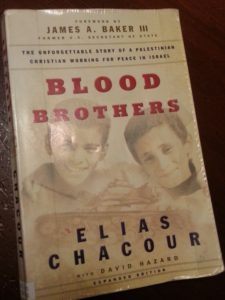 There are times when things that we should know about are lost in the avalanche of information that surrounds us each day. The stories of what happened to – and what is happening to – the Palestinian Christians is something that we should know more about. Sadly most of American Protestant Christianity has bought into a theological system that rejects these followers of Jesus while embracing the secular state of Israel.
There are times when things that we should know about are lost in the avalanche of information that surrounds us each day. The stories of what happened to – and what is happening to – the Palestinian Christians is something that we should know more about. Sadly most of American Protestant Christianity has bought into a theological system that rejects these followers of Jesus while embracing the secular state of Israel.
Though it may not be a popular stance, I firmly believe that followers of Jesus MUST stand up for each other no matter what our ethnicity or race. As such while I don’t have a problem with existences of the nation of Israel, I do have a problem with the way they treat the Palestinian Christians – not to mention Palestinians in general.
And, yes, I understand that there are Palestinian groups who are actively fighting against Israel. And yes, I know this causes security issue. So why I’m not smart enough to know how to solve the political situation, I do know that Jesus of Nazareth said to love and bless EVERYONE – even those who are trying to kill you. As such I feel that American followers of Jesus must learn how to shift through the noise to hear the voices of our Palestinian brothers and sisters who are following Jesus.
The book Blood Brothers: The Dramatic Story of a Palestinian Christian Working for Peace in Israel by Archbishop Emeritus Dr. Elias Chacour of the Melkite Greek Catholic Church is a good starting point in learning about the history of Palestinian Christians.
Published in 1984, the book starts off with Chacour’s family getting ready to celebrate the return of the Jews in 1947 to the land. As Melkite Christians, they often prayed for their Jewish “blood brothers” and were glad to have them return to the land. Sadly the military machine of the new nation didn’t like having a group of Palestinians living near the Lebanese border, so they forcefully removed Chacour’s family and all the people of Kafr Bir’im. Later on the military will destroy all the buildings in the village in an effort to keep the people from returning. Despite losing everything, Chacour’s father modeled the forgiveness of Jesus while teaching his children what it meant to be a peacemaker.
As the book goes on, the reader learns more about Chacour’s journey with Jesus and how he became a priest. Woven throughout the book is the theme of forgiveness and understanding. This is not a book that seeks to slander the nation of Israel or the Jews who were returning to the land after War World Two. Rather it looks at the historic facts while bring to light that not all the Jews who returned to the land wanted to drive out the Palestinians. Sadly the voices of peace and love were crushed under the war machine of anger and hate.
The people of Jesus are to be peacemakers. And to be a peacemaker you have to know the history of those with whom you are trying to make peace. Hence I would recommendation reading Elias Chacour’s Blood Brothers. Read it as a history lesson from a group of people hidden from American church culture and then let the message of forgiveness and peace pour out to those around you.

 There is a lot of talk these days about the symbols of the Confederacy. As a southern born and raised follower of Jesus, I thought I would add my voice to the conversation. As dangerous as that might be…
There is a lot of talk these days about the symbols of the Confederacy. As a southern born and raised follower of Jesus, I thought I would add my voice to the conversation. As dangerous as that might be… Last week I attended the
Last week I attended the 
 It was quiet.
It was quiet. We – humanity – had been restored in part to the original design in which we were made. With Jesus the Messiah as our chief cornerstone, this temple was one that spread out forwards and backwards through time, encompassing all tribes, nations, tongues, genders, races and the like.
We – humanity – had been restored in part to the original design in which we were made. With Jesus the Messiah as our chief cornerstone, this temple was one that spread out forwards and backwards through time, encompassing all tribes, nations, tongues, genders, races and the like. A Generous Man
A Generous Man
